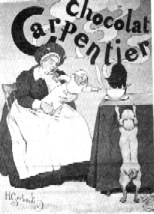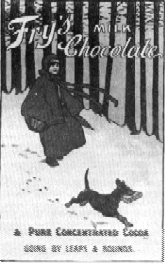Too much of a good thing can kill your dog...
 Candy is
dandy, but not for dogs. Chocolate made for human consumption can cause death in dogs.
It contains a chemical called theobromine which is toxic to dogs. Even small
amounts of it can cause: vomiting and diarrhoea. With the holidays coming, it seems an appropriate time to repeat the
message, repeat the message, repeat the message... Candy is
dandy, but not for dogs. Chocolate made for human consumption can cause death in dogs.
It contains a chemical called theobromine which is toxic to dogs. Even small
amounts of it can cause: vomiting and diarrhoea. With the holidays coming, it seems an appropriate time to repeat the
message, repeat the message, repeat the message...
A recent survey showed that the British were amongst the
top nations of chocolate eaters in the whole of Europe. Certainly we appear to be a nation of
'chocoholics.' But what if we are tempted to share our favourite sticky stuff with our beloved
dogs.
According to newly released statistics,
claims for chocolate poisoning in dogs surge by 235 per cent during the Easter
period
New data released by The Kennel Club shows
that cases of dog chocolate poisoning more than double during Easter, compared
to other months in the year. The new data, collected by The Kennel Club’s
insurance partner, Agria Pet Insurance, indicates that claims for chocolate
poisoning in dogs peak during Easter, increasing by 235 per cent during the
four-week period, causing The Kennel Club to issue a warning about the Easter
dangers for our four-legged friends, to avoid a possible seasonal health crisis.
'Easter, and spring in general, can be
very exciting for our furry friends, as it’s often a time when more people
have time for their dogs, celebrations take place and the warmer weather
bring with it longer walks and more time to explore the great outdoors,”
commented Bill Lambert, Head of Health and Welfare at The Kennel Club.
'Dogs are a part of the family and of
course can be involved in seasonal celebrations, but they can’t always enjoy
the same festivities as humans do. We want to make sure that the nation’s
much-loved dogs have a happy, stress-free and safe Easter, especially with
so many new owners navigating the chocolate-filled celebration for the first
time. For many lockdown puppies, this Easter could be the first opportunity
to meet extended family members and friends, and travel away from home too,
and it is important that this is a positive experience, where they don’t
get their paws on anything dangerous.
Simon Wheeler, Managing Director of
Agria Pet Insurance, added, 'Easter and Christmas time are two moments in
the year when we see a sharp spike in instances of dogs being poisoned by
chocolate. It is easy for dogs to sniff out chocolate and other forbidden
treats and we’d like to urge all dog owners to be extra vigilant this spring
and keep all dangerous food safely tucked away from dogs.'
To enjoy this Easter safely with your
four-legged friend, The Kennel Club, has some 'impawtant' tips:
Chocolate hazards
Every Easter, thousands of
dogs end up in need of veterinary treatment due to chocolate poisoning. Dogs are
unfortunately excellent at sniffing out not only chocolate but other seasonal
treats too and can be very inventive when it comes to getting their paws on
them.
Remember to keep any chocolate high up,
out of the reach of your dog’s paws when it’s not being eaten and be careful
when you are eating chocolate, ensuring your dog can’t get to it. Sadly, despite
their strong sniffing abilities, dogs can’t take part in the traditional egg
hunt and should be kept away from the activities or remain on lead the whole
time.
Chocolate is not the only dangerous Easter
treat for dogs, as other traditional foods include ingredients that are
poisonous to dogs. Hot cross buns and Simnel cake may contain grapes, raisins,
currants and sultanas which are toxic to dogs, so it is important to keep those
away from them and out of paws’ reach.
Family fun
With lockdown restrictions
gradually lifting, it is possible that some dogs – and puppies – will be meeting
more people than they have in months.
Encountering new people, including
children, can be stressful for dogs and especially for puppies who have spent
their first and formative months in their small family bubble. An Easter egg
hunt and lunch in the garden could be overwhelming for them with new voices,
smells and noises.
To make sure Easter celebrations don’t
become too much for your dog, make sure their routine isn’t disrupted – take
them out on their usual walks and keep dinner time the same – and make sure they
still have their usual space and bed so they can retreat and settle in their
usual spot as and when they want to.
If Easter weekend is going to be the first
time your dog meets family members due to the pandemic restrictions, make sure
it’s not too overwhelming for them and that you’ve prepared and socialised them
ahead of the event. There’s advice on socialising your puppy at home and tips to
make sure they’re ready for the ‘new normal’ available on The Kennel Club’s
online training hub:
thekennelclub.org.uk/training
Spring awakening
As Spring starts to bloom,
there are several plants and creatures you should look out for to prevent any
health concerns for your four-legged friend.
The bulbs and other parts of several
spring flowering plants can be poisonous to dogs, including daffodils, tulips
and spring crocuses. Keep an eye on your dog in the garden and always keep bulbs
out of their reach. Don’t try to make your dog sick if you think your dog might
have eaten a poisonous plant, but do contact your vet.
Spring is also a time when some creatures
become more active including slugs, snails, toads, ticks and adders, and coming
across these can be a health hazard. When your dog is exploring during spring,
check on them regularly and make sure you know what to do in case your dog is
bitten or in contact with one of the creatures. Make sure you inspect your dog
for ticks regularly, especially after walks, and always remove any ticks quickly
and carefully, speaking to your vet if you are unsure how to do this.
Post-lockdown walkies
Some dog owners might plan to
explore new walking routes further afield over the Easter weekend as the
Government’s 'stay at home' message has been lifted.
If you and your dog are planning to
discover a new route this Easter, make sure you understand how to be responsible
when walking in countryside, and around wildlife or livestock, especially during
lambing season, to keep your dog as well as other animals and humans safe.
Some areas can have seasonal restrictions
around dog walking, such as dogs being banned from beaches during certain months
and you should always familiarise yourself with these restrictions ahead of your
adventure. When walking around cattle and livestock make sure to keep your dog
on a lead and never allow your dog to approach or chase any livestock or
wildlife.
Dogs are sensitive to a class of chemicals called methylxanthines. Caffeine and theobtomine are members of that family. Dogs simply cannot
metabolise and excrete methylxanthines as efficiently as humans. The half life of those
compounds in the human body is in the order of 2-3 hours. In the dog, it is more like 18 hours.
 Repeat
Cycle Repeat
Cycle
In the dog the compounds are taken up by the liver and transmitted
via the bile into the intestines. They are then converted back into the original
methylxanthines for another circuit through the animal. This repeats itself a number of times
and instead of getting rid of the substances, the dog re-poisons itself.
Lethal Dose
There are many formulations of chocolate with varying amounts of caffeine and theobromine. The
lethal dose of sweet milk chocolate for a dog is 2 oz per kilogram of bodyweight. For a five
kilogram dog this would be about 280 grams. A lethal dose of milk chocolate for a 25 kilogram
dog would be about 1.4 kilograms.
Dark chocolate is at least ten times as lethal. A 25
kilogram dog could die from the methylxanthines in five ounces of chocolate.
Watch for these Symptoms
 Symptoms include vomiting, hyperactivity, restlessness, hypersensitivity to
touch (a dog will jump when touched), very rapid heartbeat and a rapid breathing rate. A loss
of control of leg muscles, muscle tremor, seizures, general weakness, coma and finally death
follow. So resist the temptation to share your snacks with your dog. Chocolate in any amount
can be toxic. And remember that puppies cannot digest cow's milk.
Symptoms include vomiting, hyperactivity, restlessness, hypersensitivity to
touch (a dog will jump when touched), very rapid heartbeat and a rapid breathing rate. A loss
of control of leg muscles, muscle tremor, seizures, general weakness, coma and finally death
follow. So resist the temptation to share your snacks with your dog. Chocolate in any amount
can be toxic. And remember that puppies cannot digest cow's milk.
This article is based on a copy sent in to Agilitynet of
a feature which appeared in an unknown publication. If you know the publisher, please let us
have details so that we may credit them and obtain their permission. However, we felt that the
subject was important enough for us to include on Agilitynet without the usual attributions.
Photo sources: Cadbury Schweppes (top); H. Roger Viollet
(left)
Thank you to Joyce Widlake of Epping Green AC for send
this article to Agilitynet. She makes sure that every new club member gets a copy of it when
joining.
Here are the facts and figures
on chocolate...
When Kathy Yata read this article about chocolate being toxic to dogs
on JackTalk (http://www.terrier.com).
It really scared her. Her dog Sassy, a Lab-Beagle-Vizsla cross, adores chocolate and
only gets it on the sly. Occasionally Sassy gets into semi-sweet chocolate and once into cocoa
powder without any sugar added!! The worst time was when she ate two pounds of milk chocolate,
vomited it all up within an hour (at the vet). She is 40 pounds and Kathy estimated that it was
about a half a lethal dose. Sassy was very nervous and hyper for two days. The information
reprinted here is very numerical so you can really see how dangerous the chocolate is.
Last week a reader was inquiring about chocolate being
toxic to dogs. My veterinarians gathered the following information for us, and pointed out the
timeliness of this topic.
Below is a chart giving the milligrams
per ounce of caffeine and theobromide
in various chocolates and stimulants.
| Item |
Caffeine (mg/oz) |
Theobromide
(mg/oz) |
| Milk chocolate |
6 |
55 |
| Dark chocolate |
21 |
132 |
| White chocolate |
.83 |
.25 |
| Unsweetened cocoa |
70 |
737 |
| Instant cocoa |
15 |
136 |
| Unsweetened baking
chocolate |
47 |
393 |
| Semi-Sweet chips |
22 |
138 |
Items containing caffeine, but not
theobromide (mg/oz)
| Tea |
6-12 |
| Coffee |
13-14 |
| Espresso |
100 |
| Cola |
5 |
| Stimulants (ie: No Doze) |
100-250 |
|
Analgesics |
16-100 |
| Appetite suppressants |
15-200 |
| Cold medicines |
15-325 |
Here is how to calculate whether or
not your dog has had a toxic dose of chocolate or caffeine:-
- Calculate your dog's weight in kilograms. Divide their
weight in pounds by 2.2.
- Calculate the number of mgs of caffeine and/or
theobromide your dog ingested.
- If the number of mgs is 100+ per kg of body weight, it
is time to see a vet. Pronto. He got a lethal dose. If it is close, better safe than sorry.
 Just
to give you a point of reference... Just
to give you a point of reference...
A Hershey Bar (no almonds) weighs 1.45 ozs. That means one Hershey
bar contains 88.45 mgs. of theobromide/caffeine. So, for a 12 pound (5.5 kg) dog like my Robin,
6.2 Hershey bars is a legal doze. BUT, if she ate just one ounce of baking chocolate, she would
receive 807 mgs, well over a lethal dose.
Drs. Junk and Waits could not stress enough, 'Just
avoid chocolate all together.' You never know when a dog will have an atypical reaction, or
when he has eaten more than you think.
From Mandy Love...
I've just had some sad news that my friend's Springer Spaniel,
Reg, was taken to doggy heaven earlier this morning at only eight years old. He was out walking
with us just this Sunday and seemed fine. It just shows that we don't know how much time we
have left with our precious babies.
Another friend in our group who doesn't have a dog, said
that he's brought Reg a packet of chocolate buttons on the Saturday as a treat! I
explained the dangers, but they didn't seem convinced - could this have been the cause?
Anyway, please all give your dogs an extra hug and
treat tonight, so they know how much you mean to them.
(21/01/03)
About Kathy Yata
Kathy has a chocolate-loving Lab-Beagle-Vizsla mix called Sassy and a
JRT rescue (18 months old) who has settled down enough to play agility with her a bit. She says
that he is definitely interested in watching the trials she goes to. Once she trusts him not to
run off, she says that will start classes with him.
Kathy lives in Southern California and trains with Nancy
Soyster in Camarillo.
From Arlene Phillips
A very interesting and informative page. I was put on to it when I
posted an article about Chocolate in the Obedience UK Forum. I'd like to point out that as far
as I am aware, it is the dark chocolate that can be fatal, although 'human' chocolate is not
good for dogs at all. (09/10/00)
Reprinted with kind permission of the Web Master
of the Jack Russell Terrier Club of America.
|  Just
to give you a point of reference...
Just
to give you a point of reference...